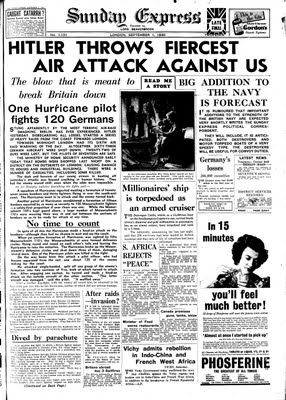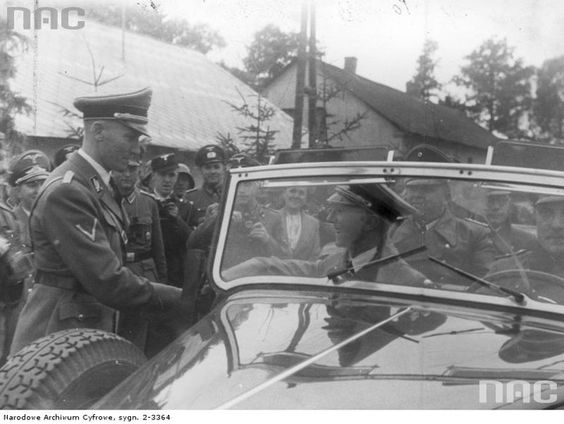Sunday 1 September 1940
 |
| An errant German bomber drops incendiary bombs in London, 1 September 1940. |
It is good flying weather again, so the Germans don't wait until the afternoon to attack as they did so often in August. Shortly before 11:00, a massive formation moves across the Channel at Dover, then, as usual, it splits up to attack multiple different targets. RAF airfields at Biggin Hill, Eastchurch, Detling, Rochford, Gravesend, Hornchurch, North Weald, and Kenley are the German visitors' destinations, but nobody is on these flights to land and go through customs to see the sights and tour the palace. All of these airfields are in RAF No. 11 Group's territory, and soon it has 14 fighter squadrons in the air in defense - virtually its entire inventory.
Numerous dogfights break out, particularly over eastern Kent. The German Dornier Do 17s and Heinkel He 111s have numerous escorts, and both sides take losses. The bombers, however, get through, or at least many of them do. Biggin Hill takes massive damage - the telephone and radio equipment that survives has to be taken out into the parking lots to use because their buildings are destroyed. The vital field at Hornchurch also takes some damage at about 11:40, but not nearly as much as Biggin Hill.
The London docks also are a prime target. The German tactic of close escorts is working, but the Luftwaffe still hasn't perfected it: on this attack, for instance, there are many more fighters than bombers, and much more damage could have been accomplished with a better ratio. However, give the Luftwaffe staff some slack here: they are groping their way forward without any precedents. This is a new mode of warfare, and the Germans are learning lessons and implementing procedures that eventually will become standard air force doctrine around the world.
The raids are incessant and continuous. The British fighters land to refuel and re-arm, and as they do more bombers come across and attack through the seams in the defense. RAF Kenley and Biggin Hill take more damage in the early afternoon, with a full Luftwaffe effort shortly before 14:00. Bf 110s sail in low over British airfields, dropping their bombs more accurately than level bombers, then help defend the vertical bombers from the RAF. While the Bf 110s are vulnerable, there is higher air cover from Bf 109s, which can come to their rescue. The Luftwaffe, having suffered many hard lessons, is using its assets efficiently for once.
Around 17:30, another Luftwaffe raid vectors in on RAF Biggin Hill. This is the seventh raid in three days, and it is the capper. A direct hit on the operations building severs all the telephone wires and destroyers the Teleprinter Network machines. At least four Spitfires are destroyed on the ground, and the airfield is completely out of action - no qualifications this time. Biggin Hill is dead for the time being. Things are so bad that a funeral service for the 50 dead men from the previous day can't be conducted - the Luftwaffe also pays its respects of a different sort at the same time.
The night is fairly quiet over England. There are isolated raids on Liverpool, Kent, Bristol Channel/South Wales, and the Tyne area. The RAF airfields hit during the night are Detling and Rye, with the Detling communications tower damaged. The Germans now are using former Lufthansa employees to assist with navigation to the larger cities such as Liverpool, with which they are well familiar. Targets hit during the night include oil installations at Llandarcy and the Newdown Downs airfield at Porthcawl, Wales.
RAF Bomber Command raids the Fiat factory in Turin and other installations at San Giovanni again, and also the BMW factory and railway installations in Munich for the first time. Other targets include engine factories at Stuttgart, the docks at Emden in northwest Germany, railway installations at Mannheim and Soest, a Kassel electrical plant, munition plants at Ludwigshafen and Hanover, and oil installations in Nordenham.
The total losses usually given for the day are deceptive and virtually worthless. Many accounts give the RAF a decided edge in terms of losses, but those figures don't factor in the planes destroyed in the air and the extensive damage to RAF (and other) infrastructure. Six RAF pilots are killed or missing, and RAF losses now exceed production. Luftwaffe fighter pilots report that fighter opposition over England is diminished from mid-August, though still fierce over key points.
In short: right now, as of 1 September 1940, the Luftwaffe is winning the Battle of Britain and accomplishing its objectives. That is not an exaggeration, that is reality. Whether that is being done quickly enough to satisfy the more strategic requirements of the entire campaign, i.e. setting up Operation Sea Lion before the weather forecloses it for the year, remains to be seen. This will be decided by Adolf Hitler in the coming days. What can be said is that the Germans finally, after much trial and error, have learned how to utilize their numerical air force advantage to the best advantage. The overriding questions are whether the Germans will keep at it and whether the British can devise effective counter-measures.
RAF No. 54 Squadron is put out of action. Several other squadrons, such as Nos. 111 at Croydon and No. 151 at Stapleford are down to only a handful of operational planes and/or pilots. RAF North Weald remains operational, but it has virtually no planes left to put in the air.
During the day, Adolf Galland at JG 26 gets his 27th victory, while his friend Hptm. Gerhard Schöpfel of Stab III./JG 26 also gets a victory. Oblt. Josef ‘Jupp’ Bürschgens of 7,/JG26 is shot down by a Bf 110 who mistakes his Bf 109 for a Spitfire. Jupp retires with 10 victories to see the sights and tour the grounds of a Canadian POW stockade.
Two German pilots, Oblt. Wilhelm Herget and Oblt. Hans-Joachim Jabs of 6,/ZG76, each file claims for three planes shot down - somewhat restoring the honor of the Bf 110 Zerstörers. Oblt. Gustav Rödel of 4./JG 27 files claims for two.
 |
| The London headlines are not quite as bombastic as in mid-August. Sunday Express, 1 September 1940. |
Battle of the Atlantic: Italian submarines have been operating off the Azores and Canary Islands for about two months with results that have underperformed expectations but still hold promise. For submarines based in Italy, these patrol stations require passage through the Straits of Gibraltar, which the British are trying to close down. Aside from the British presence, this also involves a lengthy, tiring and time-consuming transit to and from their patrol stations in the Atlantic which effectively reduces the size of the fleet. There appears to be a solution now.
To avoid the dangers of such transits and coordinate training of the under-performing Italian submarine crews, the Regia Marina Italiana now establishes a base at Bordeaux capable of holding up to 30 submarines at a time (with 1/3 of submarines in port, 1/3 in transit to or from the patrol stations, and 1/3 on patrol stations, this works out to support a fleet of up to 90 submarines, which is roughly how many the Italians have operational). This operation goes under the acronym BETASOM.
As usual with Axis joint operations, there is an involved command structure that places ultimate control over the BETASOM project in a German officer, in this case, Konteradmiral (Rear Admiral) Karl Dönitz. Doenitz now is the effective "Commander of the Submarines" (Befehlshaber der Unterseeboote) for both the German and Italian submarine fleets in the Atlantic - and the Italian fleet there potentially is even larger than the German one. This has the potential of tipping the scales of the Battle of the Atlantic decidedly in favor of the Axis. However, the effectiveness of the Italian submarines must be increased substantially for them to make a worthwhile contribution to the war effort. As part of that effort, the Italian Navy also establishes a frogmen training academy at Livorno, commanded by Lieutenant Wolk.
In the day's battle itself, results are slightly better than many recent ones for the Royal Navy but hardly wonderful. The Texel Disaster concludes with the scuttling of the destroyer HMS Ivanhoe during the afternoon and recovery of the badly damaged HMS Express, which has lost its entire bows. It will require major repairs, a virtual reconstruction of a third of the ship.
U-101 (Kptlt. Fritz Frauenheim), on her third patrol and first out of Lorient, finds a straggler from Convoy OB 205 northwest of Ireland. It is 3867-ton Croatian (maybe now Greek?) freighter Efploia. Frauenheim puts a torpedo into the Efploia which badly damages it. The ship is later scuttled by destroyer HMS Anthony, which rescues the entire crew.
U-32 (Oblt.z.S. Hans Jenisch) torpedoes British cruiser HMS Fiji northwest of Ireland, near Convoy HX 67. Fiji, seriously damaged, proceeds back to base at Greenock in the Clyde at a reduced speed of 10 knots, escorted by several destroyers. HMS Fiji has been participating in the opening stages of Operation Menace and is replaced by cruiser HMAS Australia.
British submarine HMS Tigris torpedoes and sinks Vichy French trawler Sancte Michel in the Bay of Biscay.
British submarine HMS Sunfish collides with Royal Navy launch HMML Mesme at Grangemouth, Stirlingshire. All three men aboard perish.
Royal Navy trawler HMT Royalo hits a mine and sinks off Penzance, Cornwall. All seven men aboard perish as the small ship explodes.
Royal Navy cruiser HMS Galatea hits a mine off the Humber as it is returning to port. The explosion beside B-turret is against the gunbelt and causes only minor damage.
British submarine HMS Tuna spots what it believes is a submarine in the North Sea and attacks, but without results.
Convoy FN 269 departs from Southend, Convoy MT 157 departs from Methil, Convoy FS 269 departs from the Tyne, Convoy OB 207 departs from Liverpool, Convoy HX 70 departs from Halifax, Convoy BHX 70 departs from Bermuda, Convoy SLS 46 departs from Freetown, Convoy BS 3A departs from Suez.
 |
| Germans troops on parade on Dam Square in Amsterdam, 1 September 1940. |
At 03:25, Royal Navy carrier HMS Ark Royal launches nine Swordfish to attack Caligari as part of the deception operations (Operation Squawk) to draw attention away from the Malta convoy. The planes attack at 06:00 - the Swordfish is a very slow plane, particularly in a headwind - and are back on the carrier by 08:00. After some evasive maneuvers, Admiral Somerville takes Force H toward the Sicilian Narrows (between Sicily and Tunisia). Late in the, he splits his fleet, half turning back toward Caligari and the rest (Force F) continuing eastward for a junction with the Mediterranean fleet coming from Alexandria.
The Mediterranean fleet coming from Greek waters, for its part, has had its reconnaissance planes spot the Italian fleet off Taranto. The Italians, however, apparently unaware of the British dispositions, heads back to base.
A British flotilla led by Cruisers HMS Orion and HMAS Sydney bombards the Dodecanese islands of Scarpanto (now Karpathos) and Stampalia (now Astypalea) as part of the overall deception plan. Italian motor torpedo boats MAS 536 and 537 respond by attacking the Royal Navy ships. Royal Navy destroyer HMS Ilex, operating with Admiral Cunningham's force out of Alexandria, rams and sinks Italian motor torpedo boat MAS 536 in the Aegean, but the other Italian attack boat gets away (some accounts place this on 3 September).
At Malta itself, a Hudson on reconnaissance is spotted by aircraft from HMS Illustrious, part of Force H coming from Gibraltar. Rather than a happy meeting, the Illustrious Fairey Fulmars mistake the RAF plane for an enemy one and attack the Hudson. They force it to crash-land in Tunisia, where the Vichy French intern the crew. Malta reconnaissance planes also shadow the Italian fleet returning to Taranto. The arrival of the convoy coming from Gibraltar is expected with eagerness on the morrow.
Kenya: A minor Italian offensive occupies Buna in northeast Kenya.
German/Soviet Relations: Soviet Foreign Minister Vyacheslav Molotov remains furious about the Second Vienna Award - suggesting that the Soviets itself had further plans for Romania. He privately remonstrates with the Germans, but can't go public with his aggravation because his complaint is that the German interference in eastern Europe is contrary to the secret protocols of the August 1939 Ribbentrop/Molotov Pact.
German Military: Otto Skorzeny receives a promotion to Oberscharführer (senior squad leader, roughly equivalent to a Sergeant 1st Class in the US) and joins 2nd SS Division "Das Reich." Skorzeny is a former civil engineer who has become a promising SS officer, gaining some renown for designing ramps to load tanks on ships - a potentially very useful invention should Operation Sea Lion proceed.
The Navy institutes a small force at Midway Island, part of the Hawaiian Island chain, called the US Marine Corps Midway Detachment of the Fleet Marine Force.
 |
| Vogue (US) Magazine, 1 September 1940. |
Ecuador: The new President is Carlos Alberto Arroyo.
Holocaust: A coke-fired two-retort furnace for the incineration of corpses goes into service at Auschwitz.
American Homefront: It remains hurricane season along the Atlantic coastline. The Category 2 1940 New England Hurricane passes by Cape Hatteras, North Carolina headed toward the New Jersey/New York area.
 |
| "Can Man Survive Robot Warfare?" Popular Science, 1 September 1940. Good question. |
August 1, 1940: Two RN Subs Lost
August 2, 1940: Operation Hurry
August 3, 1940: Italians Attack British Somaliland
August 4, 1940: Dueling Legends in the US
August 5, 1940: First Plan for Barbarossa
August 6, 1940: Wipe Out The RAF
August 7, 1940: Burning Oil Plants
August 8, 1940: True Start of Battle of Britain
August 9, 1940: Aufbau Ost
August 10, 1940: Romania Clamps Down On Jews
August 11, 1940: Huge Aerial Losses
August 12, 1940: Attacks on Radar
August 13, 1940: Adler Tag
August 14, 1940: Sir Henry's Mission
August 15, 1940: Luftwaffe's Black Thursday
August 16, 1940: Wolfpack Time
August 17, 1940: Blockade of Britain
August 18, 1940: The Hardest Day
August 19, 1940: Enter The Zero
August 20, 1940: So Much Owed By So Many
August 21, 1940: Anglo Saxon Incident
August 22, 1940: Hellfire Corner
August 23, 1940: Seaplanes Attack
August 24, 1940: Slippery Slope
August 25, 1940: RAF Bombs Berlin
August 26, 1940: Troops Moved for Barbarossa
August 27, 1940: Air Base in Iceland
August 28, 1940: Call Me Meyer
August 29, 1940: Schepke's Big Day
August 30, 1940: RAF's Bad Day
August 31, 1940: Texel Disaster
September 1940
September 1, 1940: RAF's Horrible Weekend
September 2, 1940: German Troopship Sunk
September 3, 1940: Destroyers for Bases
September 4, 1940: Enter Antonescu
September 5, 1940: Stukas Over Malta
September 6, 1940: The Luftwaffe Peaks
September 7, 1940: The Blitz Begins
September 8, 1940: Codeword Cromwell
September 9, 1940: Italians Attack Egypt
September 10, 1940: Hitler Postpones Sealion
September 11, 1940: British Confusion at Gibraltar
September 12, 1940: Warsaw Ghetto Approved
September 13, 1940: Zeros Attack!
September 14, 1940: The Draft Is Back
September 15, 1940: Battle of Britain Day
September 16, 1940: italians Take Sidi Barrani
September 17, 1940: Sealion Kaputt
September 18, 1940: City of Benares Incident
September 19, 1940: Disperse the Barges
September 20, 1940: A Wolfpack Gathers
September 21, 1940: Wolfpack Strikes Convoy HX-72
September 22, 1940: Vietnam War Begins
September 23, 1940: Operation Menace Begins
September 24, 1940: Dakar Fights Back
September 25, 1940: Filton Raid
September 26, 1940: Axis Time
September 27, 1940: Graveney Marsh Battle
September 28, 1940: Radio Belgique Begins
September 29, 1940: Brocklesby Collision
September 30, 1940: Operation Lena
2020


No comments:
Post a Comment